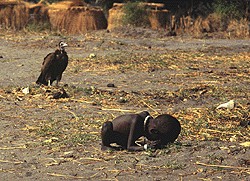![]()
Starving Child Photo
 Photojournalists
capture images that tell a story more powerfully than words. Some
insist that photojournalists are necessarily observers rather than
participants, removed from the subjects they photograph, documenting
rather than intervening. Others accuse photojournalists of emotional
manipulation and moral indifference. Controversy surrounding the
picture that won the
Photojournalists
capture images that tell a story more powerfully than words. Some
insist that photojournalists are necessarily observers rather than
participants, removed from the subjects they photograph, documenting
rather than intervening. Others accuse photojournalists of emotional
manipulation and moral indifference. Controversy surrounding the
picture that won the
Kevin Carter, a free-lance photographer, was among a group of passionate and idealistic young South African photojournalists. Nicknamed "the Bang-Bang Club" by a Johannesburg magazine for the perilous nature of their work, their mission was to make the world aware of issues of injustice. Despite imprisonment and death, they opened the eyes of the world to the appalling human suffering in Africa caused by the brutality of apartheid, war, deadly township violence, vigilante justice, and famine.
In the village of Ayod in Sudan, Carter photographed masses of starving people at a feeding station. Overwhelmed by the endless misery he saw, Carter wandered away from the feeding station into the bush. Following sounds of soft whimpering, he came upon a tiny Sudanese child, emaciated from starvation, crawling toward the feeding center. Carter decided to photograph the child. As he was doing so, a well-fed vulture landed a few feet away and began to stalk the child. Carter photographed the vulture stalking the child for several minutes, patiently hoping that the vulture would spread its wings, thereby enabling Carter to get a more dramatic shot.. It did not and Carter eventually shooed the bird away. He sat beneath a tree and cried, watching as the child continued to struggle toward the center. It is not known if the child survived.
Carter's powerful image became an
immediate symbol of Africa's desperation, and won Carter the
The photo can be viewed on several websites, including:
http://homepage.tinet.ie/~manics/MSPedia/Carter.htm
http://home.germany.net/100-496653/manics/tme/kevin_carter.htm#pulitzer
Department of Communication, Seton Hall University